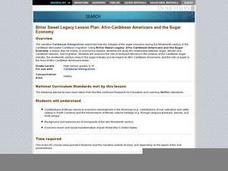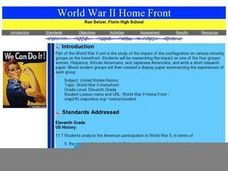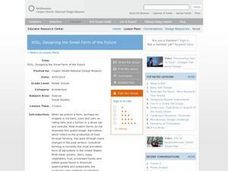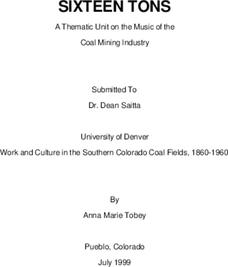Annenberg Foundation
Taming the American West
Have you ever seen a movie about the romance of the American West with its buffalo, horses, cowboys, and endless frontier? The 13th installment of a 22-part series on American history presents the myths associated with the American West....
US Holocaust Museum
Life in Shadows: Hidden Children and the Holocaust
Hiding in the filth of a sewer, as a child, to avoid capture by Nazi soldiers—sounds scary! Scholars investigate the youngest victims of the Holocaust, the children. They research video clips and written sources from the Holocaust...
Curated OER
The Cuban Revolution
In this Cuban history learning exercise, learners respond to 8 short answer questions about the Cuban Revolution and the American response to the conflict.
Curated OER
1920’s Questions
In this 20th century history worksheet, learners respond to 50 multiple choice questions about events and significant figures of 1920's America.
Curated OER
Business Practices and Competition
Students identify the costs and benefits of large corporations and monopoly industries. Using the internet, they discover how businesses use different types of exploitation to maximize their profits. They read two articles about plants...
Curated OER
NAFTA Trade Unit
Students research the geography, economics and government of Canada and how that affects US/Canadian trade relations. In this NAFTA lesson, students play a game, read about Canadian history, and creat a graph.
Curated OER
Houses or Walaloos
Investigate the legal history and application of the Fifth Amendment. Write an essay in favor of a person keeping land that has been in his/her family for decades.
Curated OER
The Ancient Mediterranean: Trade, Contact, and Cultural Diffusion
Ninth graders begin the lesson plan by being introduced to the basic terms of economics. In groups, they discover how they are affected by trade because of the clothes they wear and foods they eat. Using primary sources, they examine...
Curated OER
Afro-Caribbean Americans and the Sugar Economy
Young scholars read the narrative, Caribbean Immigration and examine how sugar production and migration of people of African origin have been intertwined for centuries. Working in three groups, they present oral reports on the three eras...
Curated OER
How Can We Make Businesses Safe And Effective?
Fourth graders complete several lessons in order to gain an overview of various facets of business. They read books about business, identify business careers that are of interest to them, write letters to local business leaders, listen...
University of Wisconsin
Why Did the Triangle Fire Occur?
An investigation of the 1911 New York City Triangle Shirtwaist Factory fire leads class members to examine primary and secondary source materials related to the event and apply what they learn about the working conditions at the time to...
Curated OER
World War II Home Front
Eleventh graders examine the political demands put on one of four groups living in America during WWII. Each class member is asked to research and write a paper describing the homefront experience for women, Hispanics, African-Americans,...
Constitutional Rights Foundation
The Election of 1912
The Election of 1912: an election with four competitive opponents. Pupils get to know the candidates with informative reading passages that provide context to the election. Then, the class engages in a debate and answers questions as one...
Curated OER
American History: Finding your Voice
High schoolers are able to write a speech and create a slogan through analysis of current issues articles dealing with pesticide use. They put themselves in the position of one of the workers affected by the story they read.
Curated OER
U.S. Expansion and the Age of Empire
In this American foreign policy instructional activity, learners respond to 20 essay questions about expansionism in the country during the 20th century.
Curated OER
Irish-Americans: Work and Song
Students research the experience of Irish immigrants who helped build the railroad systems of the United States. They analyze primary source documents, take notes, and create an artistic piece.
The New York Times
A Worker's Compensation
Middle schoolers read about the history of Labor Day in a newspaper article. They discuss difficulties American employees of the past had to face, learn about labor rallies, and conduct Internet research. Part of the intention of this...
Curated OER
Soil, Designing the Small Farm of the Future
Students examine the history of farming. In this environmental farming lesson, students explore the web and complete a variety of activities in order to understand the necessity of local, sustainable, and small farms for the future....
Curated OER
Tracing the Route of Bracero
Middle schoolers make a map showing the work of a Bracero Worker. In this Bracero lesson, students listen to a worker in an online oral history as he explains his work locations and crops. They use a map to plot the areas he worked and...
Curated OER
Coal Mine Industrial Picture Analysis
Learners observe coal mine pictures. In this US history lesson, students analyze the pictures realizing that history is shown in pictures and then write a newspaper article about life in a coal town using the pictures as...
Curated OER
SIXTEEN TONS
Students explore a variety of music related to the coal mining industry and organized labor which can be integrated into the study of Colorado History, American Labor History, and a study of immigration.
Curated OER
Literature: Esperanza Rising
Students read and discuss the book, Esperanza Rising. After analyzing and identifying the novel's structural elements, they examine working conditions for migrant workers in the 1930s. As part of the lesson, students in groups choose...
Curated OER
MEDIEVAL SUB-SAHARAN AFRICA
Seventh graders examine the area of medieval Sub-Saharan Africa through eyes of travelers in the company of one of history's greatest travelers, Ibn Battuta. The project has been structured to include all the State standards for this unit.
Curated OER
The Great Depression and the Arts
Students engage in a dialogue about the Depression, the impact of the New
Deal, the role of Franklin Delano Roosevelt, the survival of Democracy, and the
resiliency of the American spirit.























